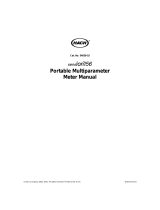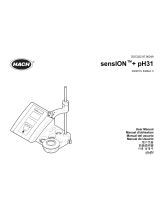Page is loading ...

Continue as follows for two-point calibration
TIP: When using two-point calibration, always bracket the expected pH value of the sample.
For example, if the expected pH of a sample is pH 5.0, use pH 7.00 and pH 4.01 buffer.
8. Apply one drop of either pH 4.01 or pH 10.01 buffer to the probe tip.
9. Depress the CAL 2 button with the tip of the clip. The meter will automatically identify the
buffer value.
10. The CAL icon will flash until a stable reading is obtained. When the CAL disappears,
calibration of the second point is complete.
11. Rinse the probe in tap water and blot dry. To measure the pH of a sample, go to Step 12.
To continue with a three point calibration, go to Step 13.
12.
Now measure the sample pH by placing a single drop on the probe tip or dipping the probe tip
into solution.
Continue as follows for three point calibration
TIP: Use three-point calibration when the expected sample pH values are completely unknown or
range both above and below pH 7.0.
13. Apply one drop of the remaining buffer (either pH 4.01 or pH 10.01) to the probe tip.
14. Depress the CAL 2 button with the tip of the clip. The meter will automatically identify the
buffer value.
15. The CAL icon will flash until a stable reading is obtained. When the CAL disappears, calibration
of the third point is complete.
16. Rinse the probe in tap water and blot dry.
17.
Now measure the sample pH by placing a single drop on the probe tip or dipping the probe tip
into solution.
Model H125
pH Meter with Silicon Chip Sensor
IQ Scientific Instruments
Calibration and Measurement Instructions
Parts
When finished, always rinse the probe and replace the protective cap.
C
Remove cap from probe
tip and turn on the meter.
Rinse the probe in tap
water and blot dry.
Apply one drop of 7.00
buffer to the probe tip. Be
sure to cover both the
reference junction and the
pH sensor.
Depress the CAL 1 button
with the tip of the clip.
The CAL and 7.0 will flash
until a stable reading is
obtained. When the CAL
disappears and 7.0 stops
blinking, calibration is
complete.
Rinse the probe in tap
water and blot dry.
To measure the pH of a
sample, go to Step 7.
To continue with a two
point calibration, go to
Step 8.
Now measure the sample
pH by placing a single
drop on the probe tip or
dipping the probe tip
into solution.
1
2
3
4
5
6
7
6. Protective Cap 7. Clip
8. Bubble
9. POWER Button
10. CAL 1 Button
1. Probe Tip pH sensor and reference electrode.
2. pH Sensor Fast response silicon chip pH sensor with built-in temperature sensor.
3. Reference Electrode Replaceable saturated KCl Ag/AgCl electrode.
4. Reference Junction Measurement is made when the reference junction and the pH sensor are
immersed in the solution.
5. LCD Display CAL (blinking): Calibration in process. Measurement cannot be made.
CAL (off): Measurement can be made.
BAT: Low battery indicator. Replace batteries.
6. Protective Cap Always replace the cap after use.
7. Clip Use the tip of the clip to depress the CAL button.
8. Bubble The reference solution bubble indicates the life of the reference electrode.
9. POWER Button Press to turn the meter on or off.
10. CAL 1 Button Button for pH 7.0 calibration.
11. CAL 2 Button Button for pH 4.0 or pH 10.0 calibration.
11. CAL 2 Button
1. Probe Tip
2. pH Sensor
3. Reference Electrode
4. Reference Junction
5. LCD Display
OPERATING INSTRUCTIONS
pH Sensor
Reference Junction
5600 Lindbergh Dr., Loveland, CO 80539
TTeecchhnniiccaall SSuuppppoorrtt::
(800) 227-4224 (U.S.A. only)
Fax (970) 669-2932
[email protected] • www.hach.com
International customers:
Tel +001 (970) 669-3050
Fax +001 (970) 669-2932
DOC022.53.80060
mini_man_H125 9/8/09 9:28 AM Page 1

SPECIFICATIONS miniLab H125
Catalog Number H125
Model miniLab H125
Meter Pocket-sized waterproof pH meter
Sensor Silicon chip pH sensor
Calibration 1,2, or 3 Point
Buffer Recognition Automatic pH 4.0, pH 7.0, pH 10.0
Temp. Compensation Automatic
Reference Replaceable KCl gel filled. Part No. RF01-01
pH Range: pH 2.0 to pH 12.0
Resolution: 0.1 pH
Accuracy ±0.1 pH
Operating Temp. Range 5 to 40 °C (40 °F to 105 °F)
Display LCD digital display
Power Auto Shut Off. Two 3v lithium batteries CR2032
Battery Life 150 hours continuous. 10 hour low battery warning.
Dimensions 152.4 x 28.57 x 16.38mm (6.0” x 1.125” x .645”) 53.94 g (1.03 oz)
Shipping Weight 1.0 lb. (.45 kg)
Troubleshooting Guide
If an error message is displayed first check the following:
No pH buffer on the pH sensor.
If the meter is reading 0.0 or 14.0, the sensor is dry
Air bubbles are trapped on the sensor surface.
pH sensor is dirty. See “Cleaning the Sensor”.
pH sensor and reference is not in solution.
BAT Message Displayed
Batteries are too low for reliable measurement. See “Replace Batteries”
(Battery Icon) Displayed
Approximately 10 hours of battery life remains. Replace batteries immediately.
Difficulty in Calibrating or in Obtaining a Stable Reading:
pH sensor is dirty. See “Cleaning the Sensor”.
The reference electrode has reached the end of its useful life. Replace reference electrode.
Interference from direct sunlight. Shade sensor from sunlight.
pH or temperature of sample is changing.
Sample has low ionic strength (tap water, distilled water).
Notes on calibration and measurement:
• Measurements cannot be made while CAL is displayed. Be sure to complete the calibration procedure before
taking pH measurements.
• Always begin a measuring session with a calibration.
• Be sure to use pH 7.00, 4.01 or 10.01 buffer as a calibration standard.
• The use of other solutions to calibrate may make measurements inaccurate.
• Rinse the sensor with distilled or deionized water when testing the pH of tap water, rainwater, or clean water.
• Although the pH meter has automatic temperature compensation, always keep the pH buffers and the samples at
the same temperature.
• To measure solids such as soil, make a slurry of the sample in deionized or distilled water.
• Keep the sensor surface clean. See “Cleaning the Sensor”.
• A white powder or gel at the probe tip is KCl reference solution. Clean from sensor before use.
• To change C°or F° temperature unit, turn off meter. Press and hold CAL 1 button, then press the POWER button
to turn meter back on.
DO:
Soak the probe in pH 7.00 (neutral) pH buffer for 5 minutes if the probe is new or has not been in regular use.
Clean the probe regularly with soft cotton tipped swab.
STORE THE PROBE DRY with the protective cap covering the probe tip. No electrode storage solution is required.
For maximum accuracy always begin each measuring session with a calibration.
Calibrate at the same temperature as the sample solution. Although the meter has automatic temperature compensation,
best results will be achieved if the calibration buffers and sample are the same temperature.
Be sure the surface of the sensor in the probe is free from any deposits or films. See the cleaning instructions in this manual.
Always place the protective cap over the sensor tip when finished measuring.
DO NOT
DO NOT store the sensor in solution or use for long term pH measuring applications.
DO NOT use below 5 °C or above 40 °C (40 - 105 °F).
DO NOT leave the sensor uncapped for long periods of time.
DO NOT allow oil, fat, food particles, starch, protein, or other materials to remain on the pH sensor after use.
DO NOT use a sharp metal object (needle, pin, etc.) to clean the pH sensor surface.
DO NOT take readings in direct sunlight. Direct sunlight may cause unstable readings or difficulty in calibration.
DO NOT use in an environment that will damage pH sensor or meter: Organic solvents (acetone, toluene, thinner, oils), strong
acids (pH 0 - 2), strong alkalis (pH 12 - 14), abrasive samples, silicon etching compounds (hydrofluoric acid).
DO NOT press the POWER or CAL buttons with sharp objects.
DO NOT submerge the meter. The meter has water-resistant O-ring seals, it is not submersible.
DO NOT use in environments with static electricity. Electrostatic discharge may permanently damage the probe.
Error Codes:
CODE Description Solution
E06 pH sensor slope error Clean probe. If error persists, replace meter.
E07 pH sensor voltage error Clean probe. Be sure sample liquid covers both sensor and reference junction.
CODE Description Solution
E08 Too long to calibrate Clean probe. If error persists, replace reference. If error still persists,
replace meter.
E13 Temperature Sensor error Replace meter
Cleaning the Sensor:
1. Clean the sensor with soapy water and a toothbrush or
cotton tipped swab.
2. Rinse the sensor with water.
3. Recalibrate.
CAUTIONS:
Do not scratch the pH sensor.
Do not press the reference electrode junction.
White powder or gel on the pH sensor is KCl reference solution. Clean before using.
Do not clean the sensor with organic solvents such as acetone, methanol, or thinner.
Replacing the Batteries:
1. Wipe the pH meter dry.
2. Pull the meter case apart as shown to the right.
3. Gently pry out the batteries and replace with two 3v lithium CR2032 batteries.
The (+) side of the batteries should face up.
4. Be sure the O-ring is not damaged and is in the correct position.
5. Reassemble the meter.
6. Recalibrate.
CAUTIONS:
Do not open the meter case if the pH meter is wet.
Always replace both batteries at the same time.
Dispose of batteries properly.
O-Ring
NOTE:
The service life of the reference electrode will vary
according to the frequency of measurement, temperature,
and other measurement conditions.
CAUTIONS:
Do not remove the reference electrode if the meter is wet.
Be sure that the O-ring seals properly. If the O-ring does
not seal properly to the meter, liquid may enter and cause
permanent damage.
Replace the Reference When...
• Liquid in the reference electrode is
depleted. Shown to the right.
• Response time slows
• There is difficulty in obtaining a stable
reading.
Replacing the Reference.
1. Wipe the pH meter dry.
2. Pull the reference electrode out of the
pH meter as shown to the right.
3. Check to be sure that the watertight
O-ring is clean and properly seated on
the new reference.
4.
Insert the new reference into the pH
meter. Part No. RF01-01.
5. Recalibrate the pH meter.
!
!
!
!
Bubble
Large air bubble,
time to replace reference electrode.
O-Ring
mini_man_H125 9/8/09 9:28 AM Page 2
/










